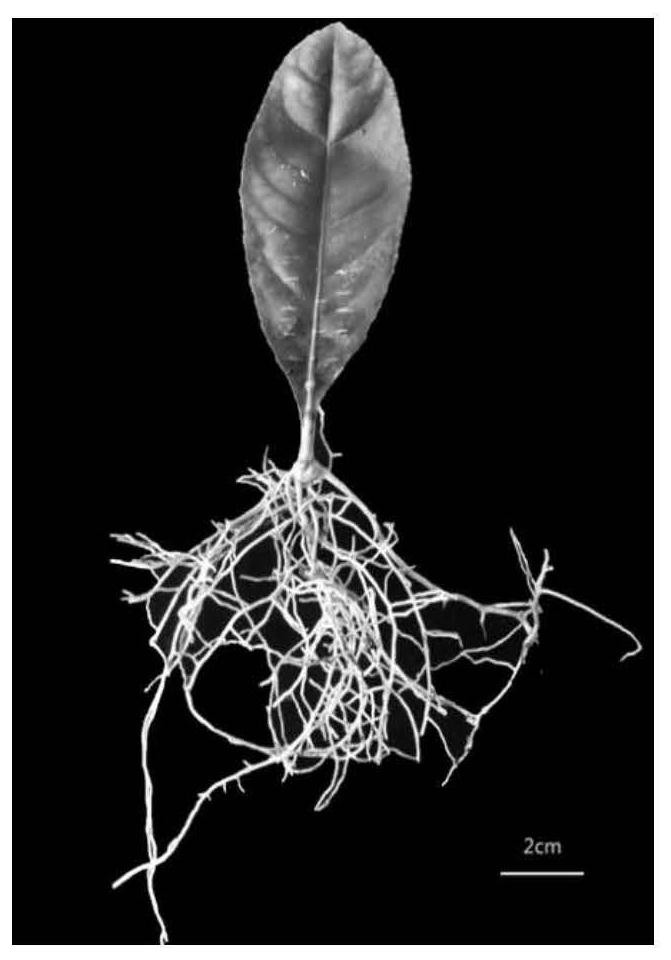A rapid inoculation and identification method for citrus canker
A technology for citrus canker and identification method, which is applied in the field of rapid inoculation and identification of citrus canker, can solve the problems of insufficient nutrient and water supply of leaves, complicated management of water, fertilizer, pests and diseases, and large space for cultivation environment, and achieves rapid and efficient screening, Reliable identification results and the effect of reducing the influence of environmental factors
- Summary
- Abstract
- Description
- Claims
- Application Information
AI Technical Summary
Problems solved by technology
Method used
Image
Examples
Embodiment 1
[0027] The operation steps of this embodiment are as follows:
[0028] (1) Sample collection: Pick 3 relatively tender leaves that have reached the maximum leaf area but have not completely turned green from the shoots of the plants, put them in a ziplock bag and mark the samples; -05 and the susceptible variety Bingtang Orange were used as controls;
[0029] (2) Pathogenic bacteria culture: Pick a single colony of ulcer disease from the preserved solid medium plate, add 20 mL liquid LB medium, shake and cultivate in a constant temperature shaker at 28°C, 200 r / min for 20 h, use sterile water Dilute the pathogen suspension to 10 3 、10 4 、10 5 、10 6 cfu / ml;
[0030] (3) Identification of canker disease by sample inoculation: After the sample is taken back to the laboratory, wipe the front and back of the leaf with alcohol cotton, turn the leaf so that the back of the leaf is facing upward, and after the alcohol evaporates, use a 1 mL syringe needle in the middle of the vei...
Embodiment 2
[0035] (1) Sample collection: Pick 3 relatively tender leaves that have reached the maximum leaf area but have not completely turned green from the shoots of the plants, put them in a ziplock bag and mark the samples; -05 and the susceptible variety Bingtang Orange were used as controls;
[0036] (2) Pathogenic bacteria culture: Pick a single colony of ulcer disease from the preserved solid medium plate, add 20 mL liquid LB medium, shake and cultivate in a constant temperature shaker at 28°C, 200 r / min for 20 h, use sterile water Dilute the pathogen suspension to 10 3 、10 4 、10 5 、10 6 cfu / ml;
[0037] (3) Identification of canker disease by sample inoculation: After the sample is taken back to the laboratory, wipe the front and back of the leaf with alcohol cotton, turn the leaf so that the back of the leaf is facing upward, and after the alcohol evaporates, use a 1 mL syringe needle in the middle of the veins on both sides. Puncture a small hole (do not pierce the leaf)...
PUM
 Login to View More
Login to View More Abstract
Description
Claims
Application Information
 Login to View More
Login to View More - R&D
- Intellectual Property
- Life Sciences
- Materials
- Tech Scout
- Unparalleled Data Quality
- Higher Quality Content
- 60% Fewer Hallucinations
Browse by: Latest US Patents, China's latest patents, Technical Efficacy Thesaurus, Application Domain, Technology Topic, Popular Technical Reports.
© 2025 PatSnap. All rights reserved.Legal|Privacy policy|Modern Slavery Act Transparency Statement|Sitemap|About US| Contact US: help@patsnap.com



